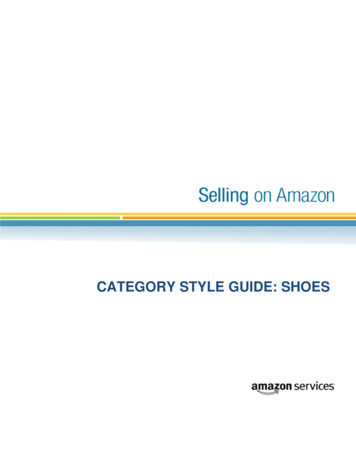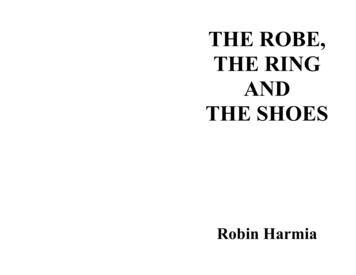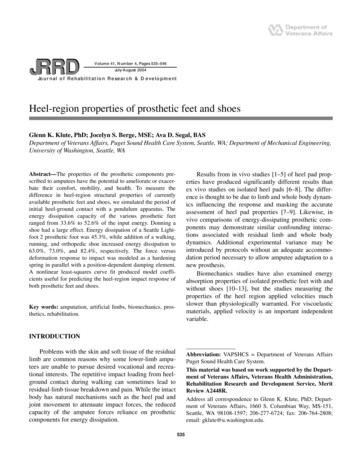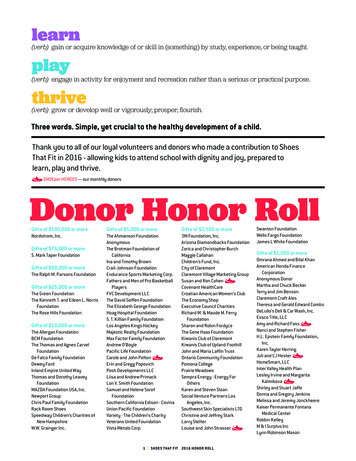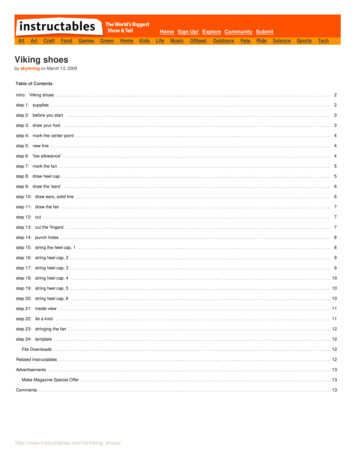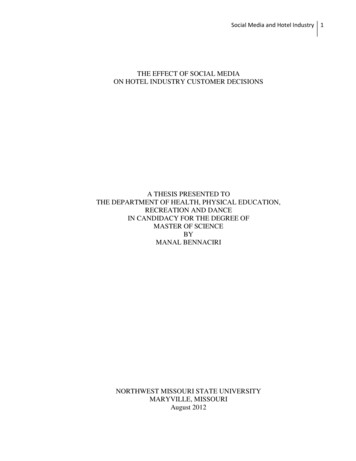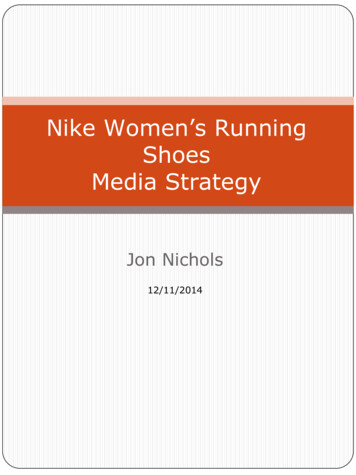
Transcription
Nike Women’s RunningShoesMedia StrategyJon Nichols12/11/2014
Table of ContentsIntroduction .1About Nike Running .2Running Trends . 4Nike’s Competition .8Industry Trends . . 17Nike’s Consumers . 18Primary Research . . .20SWOT Analysis . . .24Nike’s Target . . .25Say Hello to Lena . . . .26Media Overview . . . .27TV . . . .29Digital . . . .30Radio Streaming . . . .31Non-Traditional . . . .32Media Flowchart . . . .33Budget . . . .34Summary . . . .36Appendix . . . 37
Executive SummaryNike is the leading athletic shoe supplier in the world and one of themost well-known brands in the entire world. For this media plan, Nike hasdecided to focus on a small niche market of college women ages 18-25. Theprimary and secondary research conducted helped come to the conclusionthat this target demographic would be most receptive to Nike’s marketingand advertising. Survey results from 59 women ages 18-25 showed that88% of respondents reported using Nike and 62% rated Nike as their numberone running shoes preference. Participants also said that when purchasingrunning shoes, consumers look at function, comfort, and price. The focusgroup consisted of nine female participants between the ages of 18-21. Nikefound that 44% of participants’ main running shoes are Nike brand, and thatthe participants that purchased Nike were usually moderately activeindividuals. With this information, Nike has proposed a cross-platform mediaplan that will cover digital, radio, and event media. Digital media will includepresence MTV.com, Buzzfeed, Facebook, and Instagram. Nike will also putplaylist streaming on Spotify and Pandora. In order to reach our targetdemographic specifically, Nike will take a branded tour bus to the Big Tenschools to show women how to have fun while they exercise. With this Nikewill be able to reach a niche market in order to put Nike in the minds of theirconsumers.
IntroductionThe purpose of this Nike Running Shoes Media Strategy is designed touse strategic research and consumer insight in order to determinethe best way to convey Nike’s message to its target market. The Niketeam utilized primary research through surveys and focus groups toget a better understanding of Nike’s image to its consumers.Secondary research was used in order to determine our bestconsumer markets and what media vehicles to utilize.The following pages will show an in-depth review of research findings,including primary and secondary research on industry trends,competitor markets, consumer insights, media budgets, currentchannels of communication, and possible new media outlets.1
About Nike RunningThe Beginning1 Began in New Hampshire in 1964Founded by Philip Knight and his track coach BillBowermanStarted with the name Blue Ribbon Sports (BRS)Operated for a distributor for Onitsuka Tiger (nowASICS)Sold 1,300 pairs of running shoes in its first year ofbusiness growing over 8,000 Nike Today1 Getting There1By 1971, BRS prepared to launch its own line offootwearChanged name to Nike--the Greek goddess ofvictoryMoved headquarters to Beaverton, Oregon.By 1980, Nike had acquired 50% of the athleticshoe marketThroughout the 1980s, Nike expanded itsproduct line to include a range of athletic wearand sports equipmentNike is the leading athletic shoe supplier in theworld with over 24 billion in revenue each year.Nike is located all over the worldNike offers a variety of products includingathletic shoes, apparel, sports equipment, andathletic electronic devices.Nike focuses on innovative designs with breakthrough technology tocreate the “highest performing shoe” for its consumers.The Nike Lab is a world-class research facility that is dedicated tostate-of-the-art science in the sporting goods industry.Nike focuses on designs to increase performance and decrease injurySince Nike prides itself on its technology, it tends to be perceived ashigher quality. This affects the pricing promotion, and place of Nike,described on the next page.21"CompanyProfile." About Nike -. N.p., n.d. Web. 10 Dec. 2014.
About Nike RunningPRODUCT2 Nike has a wide variety of running shoes Nike Lab: world-class research facility that focuses on state-of-the-artscience Works to increase performance and reduce injuryPRICE2 Nike has higher average selling prices compared to most competitors. Uses vertical integration for pricing their productsPROMOTION2 Nike spends about 1.8 billion on advertising and marketing each year. Much of Nike promotional effort goes to endorsing athletes andpartnerships with sporting organizations (e.g. NFL). Nike’s print, TV and digital advertising features athletes and focuses onthe performance aspects of the shoe. Over the past ten years, Nike has decreased their print/TV advertisingby 40% and is putting more of their budget into endorsement dealsand partnerships.PLACE2 Nike is located all over the world and is the leading competitorthroughout the world for the athletic shoe industry.3Nike is a trend setter in the running footwear industry, which will bediscussed on the next page.2"Sneakernomics:Who Will Be The Next Nike?" Forbes. Forbes Magazine, n.d. Web. 09 Dec. 2014.
Running Footwear TrendsPRODUCT DEVELOPMENTNike running shoes is part of the running footwear industry. Over thepast 50 years, the running footwear industry has evolved from thin, rubbersoled shoes into modern-day shoes with elevated cushion-heels and motioncontrol in order to reduce running injuries.3 Although this was done in orderto reduce running injuries, these injuries continued to be a prevalent issueamong runners. Therefore, over the past several years there has been areversal of this trend; runners are now looking for shoes with minimalsupport that allow them to run in a natural motion.3After researching the Stanford track team and discovering that runningbarefoot allowed their athletes to run faster and have fewer injuries, Nikewas inspired to develop a shoe that mimicked a flat foot orientation.3 In2004, they created Nike Free, the first modern minimal shoe.3 The Nike Freecompletely revolutionized the idea of society’s running footwear. Over time,this brand developed into 3.0 and 7.0 versions, with the 3.0 having lesssupport and the 7.0 having more support.3Today, Nike has a variety of running footwear designs, ranging fromelevated shoes to ones with minimal support. These shoes are created to fita variety of runners needs, and styles are made specifically for track, trail,or race running.343Davis,Irene S. 2014. "The Re-emergence of the Minimal Running Shoe." Journal Of Orthopaedic &Sports Physical Therapy 44, no. 10: 775-784. SPORTDiscus, EBSCOhost (accessed October 21, 2014).
Running Footwear TrendsCURRENT TRENDS IN SALES Spending and risk4 Stable purchasing health Stable spending rate Low risk propensitySteady revenue growth4 Generated revenue of 25.313 billion during review periodthat ended on August 31, 2014 8.5% increase from fiscal year 2012 7.71% five-year growth.Maintained higher operating margin of 12.86% than itscompetitors adidas (8.29%) and Puma (2.09%)542014."NIKE, Inc. SWOT Analysis." NIKE, Inc. SWOT Analysis 1-8. Business Source Complete,EBSCOhost (accessed October 20, 2014).
Running Footwear TrendsCONSUMER USE 6Reasons for purchasing athletic footwear5 Most popular reason for buying new athletic footwear: toreplace old or worn-out shoes Younger buyers (18-34) state impulse, fashion, specialoccasions, and work requirements are also importantfactors 6 in 10 consumers have purchased at least one pair ofathletic footwear in the past yearImportant Attributes5 Most important attributes for footwear shoppers includecomfort, durability, and fashion Women place more value on fashion, while men placemore value on durability Only 7% of 25-54 year olds report that customization isimportant when selecting running shoes5Cost 77% of buyers are willing to pay more for shoes that arecomfortable 18-34 year olds are more likely to purchase less expensiveshoes, but replace them more frequently Attitudes towards footwear shopping 6 in 10 footwear shoppers enjoy shoe shopping View it as an opportunity to embrace fashion and style,or to connect with family and friends Women ages 18-34 show the highest enjoyment in footwearshopping 89% of shoppers shop in-store, but 57% have made somepurchase onlineBrand loyalty5 Among athletic shoe brands, Nike ranks second withconsumers, ages 45-65, third with consumers 25-44, andfifth with consumers 18-245Menand Women's Footwear - US September 24. (2014). Retrieved from Mintel.S. (2013, April 14). Losing a Step, Nike Seeks to Regain Its Edge. Retrieved November 1, 2014, daura.html?pagewanted all& r 1&6Elliott,
Running Footwear TrendsADVERTISING TRENDS Nike’s early success due to prominent, well-respected athletessuch as Michael Jordan6Nike’s advertisements used to be energetic, confident and cheeky,but now they are having a harder time standing out as cool6o Slogans used to be extremely popular “Gotta be the shoes” “You don’t win silver, you lose gold” “There is no finish line” “I am not a role model”Nike revolutionized the sports advertising industry, but now thatthey are no longer the new brand in the industry they arestruggling with their maturity6o They are adjusting to the shift of fragmentation of audienceand the media, and they are figuring out how to market totheir consumers in a new technology age1995-2012: Spent more than 3.2 billion to run ads6 115.7 million in 2012 alone, an increase of 20.2% from 96.3 million in 2011January-June 2014: Spent 56.4 million on TV commercials6 Spending mostly on NBC Sports, ESPN, and Univision duringathletic programming such as the Winter OlympicsRisk Everything 2014 Campaign6 Multichannel campaign for 2014 World Cup Designed to appeal to youth, tech-savvy demographic andcreate an edgy feel Featured soccer apparel, interactive website, Nike SoccerApp, television ad featuring star soccer playersNike has a long history of innovative advertising compared to theircompetitors, who will be analyzed next.6Elliott,7S. (2013, April 14). Losing a Step, Nike Seeks to Regain Its Edge. Retrieved November 1,2014, from a.html?pagewanted all& r 1&
Nike’s nor
Category: Running ShoesThe brand category of running is characterized as competitivebecause there are multiple stable brands who hold a portion in themarketplace and continue to generate sales. The principal methods ofcompetition in our category which Nike and the competing brandsprovide are the following: product design, product performance, quality,brand image, price, marketing and promotion, customer support andservice, and ability to meet delivery commitments to retailers.77GlobalAthletic Footwear Market is Expected to Reach USD 84.4 Billion in 2018: TransparencyMarket Research. (n.d.). Retrieved October 11, 2014, from 751.html9
Financial AnalysisAdidas: Second leading manufacturer of running footwearRevenue as of Dec. 2013: 18 billion8Profit Margin: 11%Global Market Share: 15%Puma: Third leading manufacturer of running footwearRevenue as of Dec. 2013: 4.7 billion8Profit Margin: 4%Global Market Share: 6%8Von10der Heydt, A. (2013, November 12). How Puma Can Compete With Adidas And Nike. RetrievedDecember 10, 2014, from 81329-how-pumacan-compete-with-adidas-and-nike
Brand PositioningAdidas:Making ALL athletes better, with innovation at the heart of all adidasproducts. From a category perspective, football, running and basketball aretheir key strategic categories for growth. However, to underline credibilityas the multi-sport specialist and spark brand strength, adidas also supportsa wide range of other sports and activities such as training, Americanfootball, rugby, tennis, baseball, handball, volleyball, badminton andboxing.9“Innovation AND making athletes better”Puma:Previously pitching its shoes and clothing to those who live casual hipsterlifestyles, Puma is shifting its marketing focus to serious athletes. Puma“wanted to reposition itself as a sports-performance brand rather than thecasual thing it was,” said Julian Easthope, a Barclays Capital analyst. Pumaaims to be the fastest sports brand in the world.9“Bona fide athletes AND Troublemakers”9Global11Brands Strategy. (n.d.). Retrieved December 11, 2014, from lobal-brands-strategy/#/adidas-strategic-positi
Advertising AnalysisAdidas“The Dream: All in or Nothing”10The ad begins with Messi asleep and dreaming of himself and fellow star footballersas they prepare for the 2014 FIFA World Cup Brazil. Attention then turns to cuttingedge football action on the field, with leading adidas players going “all in”, showingoff extraordinary skills. Players, fans, managers and nations all join together intheir desire for the ultimate prize, before Messi awakes knowing it is time to go ‘allin or nothing’ for 2014 FIFA World Cup Brazil.As it comes to an end, the viewer willbe pre
competitors adidas (8.29%) and Puma (2.09%) 5 4 2014. " NIKE, Inc. SWOT Analysis ." NIKE, Inc. SWOT Analysis 1-8. Business Source Complete , EBSCO host (accessed October 20, 2014). Running Footwear Trends CONSUMER USE B Reasons for purchasing athletic footwear 5 Most popular reason for buying new athletic footwear: to replace old or worn-out shoes v Younger buyers (18-34) state
